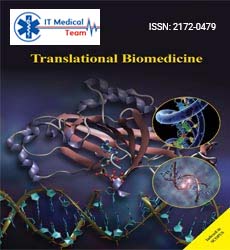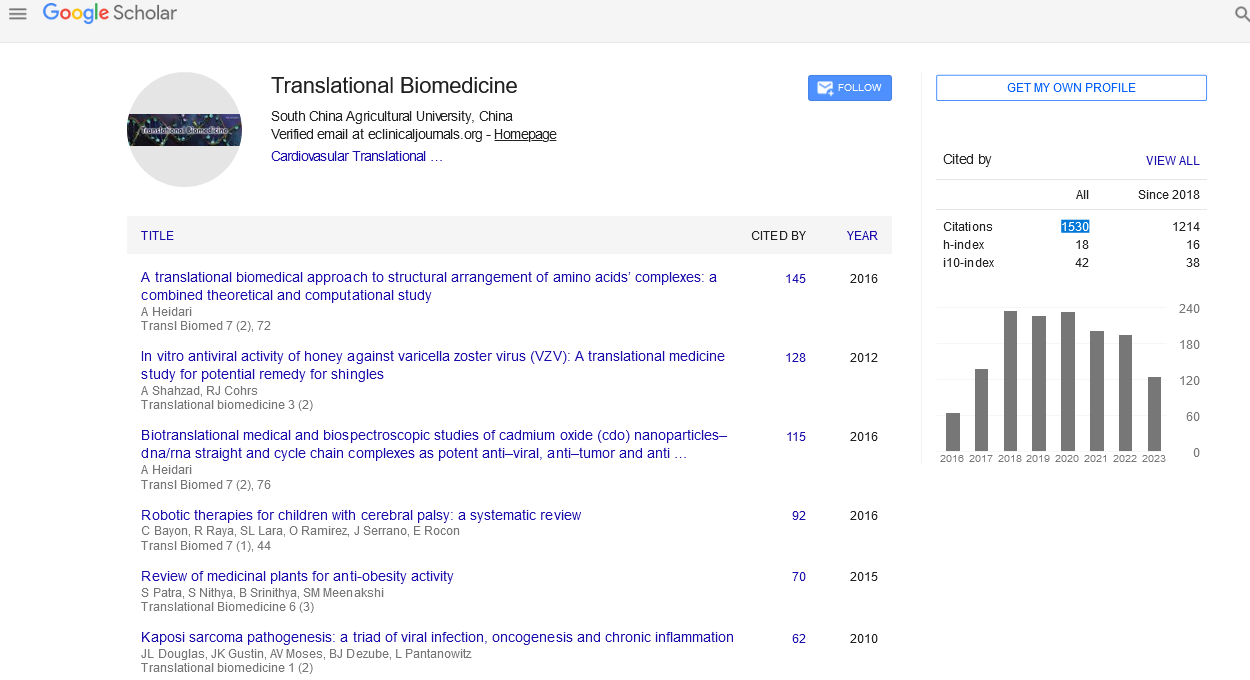Perspective - (2024) Volume 15, Issue 2
Lignocellulosic Biomass-Based Glycoconjugates: A Sustainable Approach for Bioproduct Development
Andrew Cant*
Department of Biotechnology, Asut University, Giza, Egypt
*Correspondence:
Andrew Cant, Department of Biotechnology, Asut University, Giza,
Egypt,
Email:
Received: 06-Mar-2024, Manuscript No. IPTB-24-14649;
Editor assigned: 11-Mar-2024, Pre QC No. IPTB-24-14649 (PQ);
Reviewed: 25-Mar-2024, QC No. IPTB-24-14649;
Revised: 02-Apr-2024, Manuscript No. IPTB-24-14649 (R);
Published:
10-Apr-2024
Introduction
In the face of climate change and the growing need for
sustainable alternatives, researchers are increasingly turning to
lignocellulosic biomass as a valuable resource for the development
of bio-based products. Lignocellulosic biomass, derived from plant
cell walls, is abundant, renewable and represents a promising
avenue for the production of glycoconjugates. Glycoconjugates,
compounds formed by the combination of carbohydrates with
other molecules, have diverse applications in medicine, industry
and agriculture. This article explores the potential of lignocellulosic
biomass-based glycoconjugates and their significance in the quest
for sustainable bioproduct development.
Description
Lignocellulosic biomass: A renewable resource
Lignocellulosic biomass is primarily composed of cellulose,
hemicellulose and lignin, making it an abundant and sustainable
resource. Cellulose, the most abundant biopolymer on Earth,
forms the structural framework of plant cell walls. Hemicellulose
and lignin provide additional support and protection to plant
tissues. The ability to harness the inherent complexity of
lignocellulosic biomass opens up a myriad of opportunities for
sustainable product development.
Glycoconjugates: The essence of biomolecular
complexity
Glycoconjugates, often referred to as glycomolecules, are
compounds resulting from the combination of carbohydrates
with other molecules, such as proteins, lipids or nucleic acids.
Carbohydrates, also known as sugars, are essential biomolecules
involved in various biological processes. The conjugation of
carbohydrates with other molecules enhances the functional
diversity and complexity of biomolecules, allowing for a wide
range of applications in medicine, industry and agriculture.
Production of lignocellulosic biomass-based
glycoconjugates
The conversion of lignocellulosic biomass into glycoconjugates
involves several steps, including pretreatment, hydrolysis and
functionalization.
Pretreatment methods such as steam explosion or acid
hydrolysis are used to break down the complex structure of
biomass and facilitate enzymatic hydrolysis of cellulose and
hemicellulose into their constituent sugars. The resulting
sugar moieties can then be conjugated to other
molecules through chemical or enzymatic reactions.
One approach to producing lignocellulosic biomass-based
glycoconjugates is through the enzymatic modification of sugars
obtained from biomass hydrolysis. For example, xylose, a major
component of hemicellulose, can be enzymatically converted
into xylose-phenol conjugates using laccase enzymes. These
conjugates exhibit antioxidant properties and have potential
applications in food and pharmaceutical industries.
Another strategy involves the chemical modification of lignin,
the aromatic polymer present in biomass. Lignin can be
depolymerized and functionalized to introduce carbohydrate
moieties, creating lignin-carbohydrate conjugates. These
conjugates have been explored for applications such as
bioplastics, adhesives and emulsifiers.
Isolation of cellulose, hemicellulose and lignin: The first step
in the production of lignocellulosic biomass-based
glycoconjugates is the extraction of cellulose, hemicellulose and
lignin from the raw plant material. Various methods, such as
chemical, physical or enzymatic treatments, can be employed to
break down the complex structure of plant cell walls and isolate
the individual components.
Chemical modification for glycoconjugate synthesis: Chemical modification of cellulose, hemicellulose or lignin involves
introducing functional groups that facilitate glycoconjugate
synthesis. Common chemical modifications include acetylation,
oxidation or esterification, which enhance the reactivity of the
biomass components for subsequent conjugation reactions.
Carbohydrate component: The carbohydrates obtained from
lignocellulosic biomass can serve as the carbohydrate
component of glycoconjugates. These carbohydrates can be
further modified or combined with other carbohydrate
structures to achieve the desired glycoconjugate properties.
Applications of lignocellulosic biomass-based
glycoconjugates
The versatility of glycoconjugates makes them attractive for
various applications across different industries. Lignocellulosic
biomass-based glycoconjugates have shown potential in the
following areas:
Medical applications: Glycoconjugates play a crucial role in
medicine, particularly in the development of vaccines,
diagnostics and targeted drug delivery systems. Lignocellulosic
biomass-based glycoconjugates offer a sustainable alternative to
traditional sources of carbohydrates, such as animal tissues or
synthetic materials, reducing the environmental impact of these
medical applications.
Industrial applications: In the industrial sector,
glycoconjugates find applications in the production of
biopolymers, surfactants and adhesives. Lignocellulosic biomass,
with its abundance and renewability, provides an eco-friendly
source for the synthesis of glycoconjugates used in various
industrial processes.
Agricultural applications: The use of glycoconjugates in
agriculture is gaining traction for improving crop yield, disease
resistance and nutrient uptake. Lignocellulosic biomass-derived
glycoconjugates can be tailored to enhance plant-microbe
interactions, promoting a more sustainable and efficient
agricultural system.
Challenges and future perspectives
While the potential of lignocellulosic biomass-based
glycoconjugates is promising, there are challenges that must be
addressed to facilitate widespread adoption:
Technological challenges: The extraction and modification of
lignocellulosic biomass components require advanced
technologies and efficient processes.
Research efforts are needed to develop cost-effective and
scalable methods for producing lignocellulosic biomass-based
glycoconjugates on an industrial scale.
Structural complexity: The structural complexity of
lignocellulosic biomass poses challenges in terms of controlling
the degree and site of modification for glycoconjugate synthesis.
Achieving precise control over the glycoconjugate structure is
crucial for optimizing their properties and applications.
Environmental impact: While lignocellulosic biomass is a
renewable resource, the environmental impact of chemical
treatments and modifications must be carefully considered.
Researchers are actively exploring greener and more sustainable
approaches to minimize the ecological footprint of
glycoconjugate production.
Market acceptance: The acceptance of lignocellulosic
biomass-based glycoconjugates in the market depends on
factors such as cost competitiveness, performance and
regulatory approval. Establishing the economic viability and
safety of these bio-based products is essential for their
successful integration into existing industries.
Conclusion
Lignocellulosic biomass-based glycoconjugates represent a
promising avenue for sustainable bioproduct development.
Leveraging the inherent complexity of plant cell walls,
researchers can extract and modify cellulose, hemicellulose and
lignin to create versatile biomolecules with applications in
medicine, industry and agriculture. While challenges exist,
ongoing research efforts are addressing technological, structural
and environmental concerns, paving the way for the widespread
adoption of lignocellulosic biomass-based glycoconjugates. As
we continue to explore innovative solutions for a more
sustainable future, these bio-based glycoconjugates offer a
tangible pathway towards greener and more environmentally
friendly practices in various sectors.
Citation: Cant A (2024) Lignocellulosic Biomass-Based Glycoconjugates: A Sustainable Approach for Bioproduct Development. Transl Biomed.
Vol.15 No.2: 015





